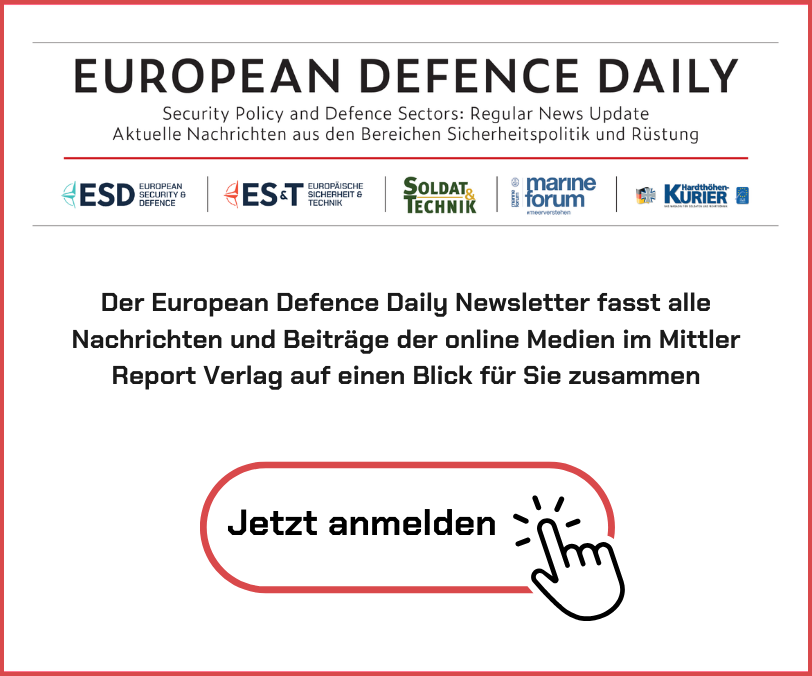Under the patronage of Schleswig-Holstein's Minister President Daniel Günther, hundreds of experts came together in September to identify solutions to one of the greatest threats in the North and Baltic Seas.
The seabed offers mineral resources and flora that make a significant contribution to the regeneration of the atmosphere. But for more than a century, it has also become a receptacle for the legacies of civilisation.
During the Kiel Ammunition Clearance Week around 500 experts from politics, business, environmental protection, science and the navy, 150 of whom were on site, dealt with a special type of waste. It was about the more than 1.5 million tonnes of old munitions that are facing a rather disintegrating future at the bottom of the North and Baltic Seas. Not only do the substances from the explosives end up in the water and are now regularly detected in plants and animals. Carcinogenic components even reach humans via the food chain. What's more, in his keynote speech, the Federal Government's Coordinator for the Maritime Economy Norbert Brackmann addresses the economic aspects: "Shipping, harbours, fishing and tourism at sea are affected by the munitions waste in the sea. Even the energy transition has points of contact, as munitions remnants lying around hinder offshore installations and the laying of submarine cables."
The public representatives at the symposium included Schleswig-Holstein's Ministers for Energy Transition, Agriculture, Environment, Nature and Digitalisation as well as Economics, Transport, Labour, Technology and Tourism, Jan Philipp Albrecht and Bernd Buchholz, the Programme Manager at the Strategic Environmental Research and Development Programme, Dr David Bradley, Professor Dr Katja Matthes, Director of GEOMAR, and Professor Gabriel Felbermayr, Director of the Kiel Institute for the World Economy.
The topic was approached in eight lecture and discussion sections. The experts exchanged views on individual focal points in a series of workshops and presentations. Technologies and possible applications for the detection, identification and movement of munitions, including the possibilities and limitations of using autonomous and remote-controlled underwater vehicles, were widely discussed. In one panel, the speakers dealt with the potential of artificial intelligence in detection and classification. The contributions of the various stakeholders who play a role in search and disposal were also discussed, as were the financing options for detection and disposal measures. The European Commission is helping its member states, primarily with funding, for example for European research projects or for regional cooperation in the field of contaminated site remediation.
The need for action is not only recognised in Germany. The issue is pending in the European Parliament. On behalf of the EU Commission, Christos Economou, Head of Unit Marine Policy and Blue Economy in the Directorate-General for Maritime Affairs and Fisheries, explained that the EU's Marine Framework Directive obliges all member states to maintain a good environmental status in the waters surrounding the Union or to take appropriate measures to achieve this in the near future.

The national navies of the member states play a leading role in the removal of munitions waste in the European seas. The only exception here is Germany.
Vice Admiral Kay-Achim Schönbach, Inspector of the Navy, referred to the experience that his branch of the armed forces has gained in over 60 years. The German Navy has unique knowledge of local conditions, which can be utilised for detection and identification. He also outlined the expertise in the safe detonation of ammunition that cannot be recovered due to corrosion. In addition, the navy could also contribute skills in the storage, processing and provision of data. "However, the navy cannot solve the problem alone; it requires an all-hands-on-deck manoeuvre in close cooperation with the private sector and the relevant authorities and stakeholders." He emphasised that the navy could only contribute due to the constitutional circumstances, as it could only support the federal states within the framework of requests for administrative assistance. But in conclusion, Schönbach also made an offer: "The German Navy will of course continue to support the resolution of contaminated sites in the Baltic Sea within the scope of its possibilities." And assured: "... that we as the Navy will stand by your side."
On the afternoon of 8 September, conference visitors were able to gain a personal impression of German mine detection and defence capabilities. The 3rd Minesweeper Squadron from Kiel and the mine diving company of the naval battalion from Eckernförde demonstrated their skills and were then available for technical discussions at the Kiel naval base.
For now, only words remain
The urgent need for action was illustrated to the conference participants with a small calculation: between 2013 and 2020, a total of 26,192 unexploded ordnance (UXO) items were discovered and cleared. If one were to assume a 500-pound bomb in each case, the total mass would amount to 13,456 tonnes. Or to put it another way: during this period, it was possible to dispose of around 1682 tonnes per year. At the same rate, it would therefore take 892 years to dispose of the 1.5 million tonnes of old munitions in the North and Baltic Seas.
"After this high-quality exchange across the different areas of expertise, it is now time to move from talking to action and finally tackle and eliminate the dangers lying dormant in the depths to protect the marine environment and shipping," demanded Jann Wendt, initiator of the first Kiel Munitions Clearance Week and Managing Director of north.io GmbH, at the end of the event. Despite all the appeals, the binding declaration of intent on further action expected by some participants failed to materialise.
So there was no shortage of insights and frank statements. However, observers could not help but get the impression that there was an obvious lack of will to actually tackle something. An unmistakable sign of this was the fact that of the five federal states that make up the Maritime Cluster Northern Germany, only Schleswig-Holstein was represented by political representatives.
Author: Hans-Uwe Mergener










